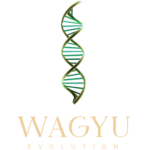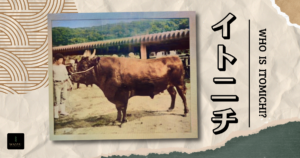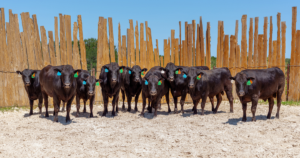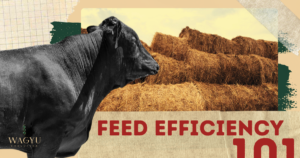In simple terms, genetics in relation to Wagyu agriculture consists of two factors: how the choice of animals from a specific breed (or breeds) affects its current performance and how that choice affects performance in the following generations – the latter is usually termed genetic improvement. Both of these choices largely depend on identifying individual cattle with more favorable genetic makeup for a specific goal that the breeder wants to be the outcome. To do this, the breeder will need to define the goal by choosing what aspects of traits are important to them and what they wish to alter in the existing breeds – this is called finding your breeding objective. Secondly, the breeder will need to select individual cattle that have the superior genetic makeup of the breeding objective and mate them in an optimal way to produce favorable offspring.
Importance of selecting healthy and hardy animals when breeding
Selecting healthy and hardy cows when breeding Wagyu cattle is critical to ensure the long-term success and sustainability of the breeding program. According to the American Wagyu Association, healthy cows are less likely to suffer from illnesses and diseases, reducing the risk of production losses and the need for expensive veterinary treatments. Additionally, healthy cows are more resilient to environmental stressors, such as changes in temperature, humidity, and feed quality, which can impact animal welfare and performance.
Hardy cows possess desirable genetic traits, including superior growth rates, meat quality, and disease resistance. Breeding these traits into the Wagyu cattle herd can improve the overall productivity and profitability of the breeding program. Selecting these cows requires careful attention to breeding and genetic selection, as well as ongoing monitoring and management of animal health and welfare. By prioritizing the selection of healthy and hardy cows, breeders can ensure the long-term success and sustainability of their Wagyu cattle breeding program, producing high-quality, high-value beef for years to come.
Phenotypic Traits & Selection Criteria
Key phenotypic traits to consider when selecting animals for breeding
When selecting Wagyu cattle for breeding, several key phenotypic traits must be considered. These traits include body size and conformation, marbling and meat quality, fertility and reproductive performance, and disease resistance. Body size and conformation (the overall physical structure of the cattle, including shape, size, and proportions of various body parts) can impact feed efficiency and carcass yield while marbling and meat quality are critical for producing high-value Wagyu beef.
Fertility and reproductive performance are essential traits for maintaining herd size and productivity, and disease resistance is vital for reducing the risk of production losses and veterinary expenses. Selecting animals with desirable phenotypic traits is critical to breeding high-quality, healthy, and profitable Wagyu cattle.
Selection criteria for conformation and meat quality
When selecting for conformation and meat quality in Wagyu cattle, breeders look for specific physical traits that are indicative of good meat production. Meat quality, on the other hand, is determined by a range of factors, including the amount of marbling in the meat, texture, flavor, and tenderness.
For selective breeding, breeders typically look for animals with a balanced body structure, good muscling, and a deep, broad chest. They also pay close attention to the size and shape of the animal’s head, legs, and hooves, which can all impact overall health and mobility. This helps with the overall flavor and taste of Kobe beef.
Likewise, when it comes to meat quality, breeders look for animals with high levels of marbling, which refers to the fat that is dispersed throughout the meat. Animals with good marbling typically produce meat that is more tender, flavorful, and juicy – this is often a more sought-after trait for Angus cows, among other types of Wagyu meat. In addition, breeders may also consider factors such as meat texture, color, and aroma when selecting meat quality.
Genomic Technologies & Targeted Selection
Genomic technologies and targeted selection are modern breeding strategies in the field of animal science that are used in animal and plant breeding that leverage advances in genetic sequencing and analysis to accelerate the pace and precision of breeding efforts. These new technologies allow breeders to analyze the genetic makeup of individual Wagyu breed cattle with high precision, identifying specific genes and genetic variations that influence traits of interest in the different breeds of Wagyu cattle such as; Japanese brown Wagyu, f1 Wagyu, Japanese shorthorn, Japanese black, and fullblood Wagyu also known as 100 percent fullblood Wagyu). This data can then be used to make informed breeding decisions, such as selecting animals or plants with the most desirable genetic traits for further breeding.
Targeted selection refers to the process of selecting animals or plants based on specific genetic markers or traits, rather than relying on traditional phenotypic selection alone. According to the Australian Wagyu association, this approach can be particularly useful for identifying desirable traits that may not be visible or measurable through traditional means, such as disease resistance or heat tolerance, especially in cases where the Wagyu cattle are imported and need to adjust to new environments and climates. For example, American Wagyu will not be bred the same way that Japanese Wagyu is bred – whether it is fullblood Wagyu or not, due to the difference in weather in the two different countries.
Overall, using genomic technologies and targeted selection can significantly accelerate the pace and precision of breeding efforts, allowing breeders to produce more productive, healthy, and resilient cows for better beef cattle with overall great meat quality. This can lead to significant improvements in food production and agricultural sustainability, helping to meet the growing demand for high-quality, sustainable food around the world.
How genomic technologies are used in targeted selection
The first step in targeted selection is to collect DNA samples from a group of animals or plants within a breeding population. These samples are then sequenced and analyzed to identify genetic markers associated with traits of interest, such as growth rate, disease resistance, meat quality, tenderness, and flavor. this can be done by looking at the different breeds of Wagyu cattle such as; the black Wagyu, fullblood Wagyu, purebred Wagyu, red Wagyu, Japanese brown Wagyu, Japanese black Wagyu Japanese shorthorn Wagyu (and all other Japanese cattle Wagyu) and the Australian Wagyu – just to list a few.
Once these markers have been identified, breeders can use them to select animals with the most desirable genetic profiles for further breeding. This can involve selecting animals – for example, Wagyu bull, with specific combinations of genetic markers – such as superior marbling – or selecting specific traits based on the presence or absence of certain markers, as is the case with Japanese Cow and Angus cattle.
Advantages of using genetics in selection decisions
Using Wagyu genetics in selection decisions offers several advantages for animal breeding, including:
Increased accuracy and precision:
By analyzing the genetic makeup of Wagyu cattle, breeders can identify specific genes and genetic markers that influence traits of interest. This can help to make more informed selection decisions, leading to more precise and accurate breeding outcomes. this is especially significant when dealing with fullblood Wagyu because as a pure breed, these cattle require a lot of precision and accuracy to assure the best traits are taken advantage of for future Wagyu calves.
Faster breeding progress:
By using genetic markers to select specific traits with Wagyu genetics, breeders can accelerate the pace of breeding progress. This can help to produce more healthy and resilient animals in a short amount of time. For example, a Wagyu calf with more desirable genetic traits due to selective breeding is likely to produce more desirable outcomes for the Wagyu breeder.
Reduced costs and risks:
Traditional breeding methods can be costly, time-consuming, and (may) involve significant risks associated with unpredictable genetic outcomes. Using genetics in selection decisions can help to reduce these costs and risks, leading to more efficient and effective breeding outcomes, such as the amount of fatty acid in the meat and marbling.
Improved sustainability:
according to the American Wagyu association by selecting specific traits, Wagyu breeders can produce Wagyu cattle that are better adapted to their environments and more resilient to stressors such as climate change and disease. This can help to promote agricultural sustainability and reduce the environmental impact of farming especially when it comes to grass fed Wagyu.
Selection Indices & Culling Strategies
A selection index is a mathematical formula that combines multiple traits of economic importance into a single value, which can be used to rank animals based on their overall breeding value. Selection indices are a useful tool for making informed decisions on which animals should be kept or culled in animal breeding programs.
To create a selection index, breeders first identify the traits of economic importance for their particular breeding program. These might include factors such as growth rate, meat quality, fertility, and disease resistance, among others. Breeders then assign weights to each trait based on their relative economic importance and use this information to calculate a breeding value for each animal.
By using a selection index, breeders can make more informed decisions on which animals to keep or cull based on their overall breeding value. Animals with higher breeding values are more likely to produce offspring with desirable traits and are therefore more valuable to the breeding program. On the other hand, animals with lower breeding values may be culled to make room for more promising candidates.
Using a selection index can help to improve the efficiency and effectiveness of breeding programs, leading to more productive, profitable, and sustainable outcomes. By selecting animals based on their overall breeding value, rather than individual traits, breeders can produce animals that are better suited to their environment and more resilient to stressors such as climate change and disease, ultimately benefiting both farmers and consumers.
Common selection indices used in Wagyu cattle
In Wagyu cattle, several selection indices are commonly used to make informed decisions on which animals should be kept or culled. Here are some of the most common selection indices used in Wagyu cattle breeding:
Terminal Index: The Terminal Index is designed to maximize the value of Wagyu carcasses for beef production. It is calculated based on a combination of growth rate, carcass weight, meat quality, and other factors that influence beef value.
Balanced Wagyu Index: The Balanced Wagyu Index is a multi-trait selection index that is designed to balance the importance of meat quality and growth rate. It takes into account factors such as marbling score, carcass weight, and gestation length – among others.
Self-Replacing Index: The Self-Replacing Index is a selection index that is designed to optimize the economic value of a breeding program over the long term. It takes into account factors such as fertility, calving ease, growth rate, and meat quality.
Challenges & Ways to Overcome Them
Common challenges faced by producers when it comes to genetic improvement and selection
Limited genetic diversity: Due to the relatively small population size of Wagyu cattle and the strict breeding practices used to maintain their unique characteristics, there is limited genetic diversity within the breed. This can make it difficult to make significant improvements in specific traits without introducing undesirable traits.
Complex traits: Many of the characteristics that are important for Wagyu production, such as marbling score and meat quality, are complex and difficult to measure accurately. This makes it challenging to select animals with the desired traits, mainly if the desired traits are only fully expressed in certain conditions or environments, this is applicable to Japanese beef, and fullblood Wagyu.
Cost and time: Genetic improvement and selection require significant investments of time and money. This is particularly challenging for smaller producers or those with limited resources.
Market demand: The demand for Wagyu beef varies depending on the region and market, and is influenced by factors such as consumer preferences and economic conditions. This makes it challenging for producers to optimize their breeding programs to meet market demands.
Maintaining breed purity: The strict breeding practices used to maintain the unique characteristics of Wagyu cattle makes it challenging to maintain breed purity, particularly if crossbreeding is introduced.
How to ensure the sustainability of Wagyu genetics for the future
Maintaining genetic diversity: To avoid the negative consequences of inbreeding, Wagyu breeders should focus on maintaining genetic diversity within the breed. This can be achieved through careful selection of breeding stock and by avoiding excessive reliance on a small number of highly valued individual cattle.
For example, TF 148 Itoshigenami created and imported into the U.S. by Shogo Takeda, who is one of the original importers of fullblood black Wagyu, has one of the highest impacts on carcass quality in the Wagyu breed, but it has and it is being used excessively in herds around the world.
Implementing effective breeding programs: By using selection indices, genomic technologies, and other tools, Wagyu breeders can optimize their breeding programs to improve the productivity, profitability, and sustainability of their operations. Effective breeding programs can help to produce animals that are better adapted to their environment and more resilient to stressors such as climate change and disease.
Collaborating with other breeders and organizations: Collaboration between Wagyu breeders and organizations can help to share knowledge, expertise, and resources, and to develop more effective breeding programs. Working together can also help to promote genetic diversity and maintain the integrity of the breed.
Implementing sustainable production practices: In addition to genetic improvement, Wagyu producers should also focus on implementing sustainable production practices. This includes sustainable grazing practices, feed management, and waste management, among other factors. By adopting sustainable practices, producers can improve the environmental sustainability of their operations and reduce their impact on natural resources




